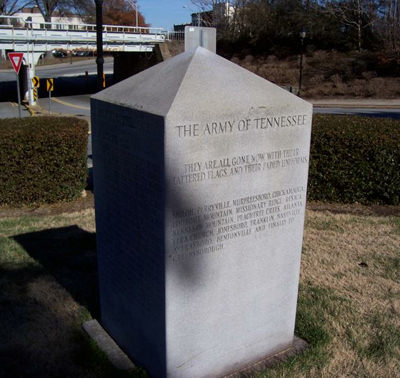
Army of Tennessee Monument, Greensboro
Sometime after 2020 the memorial has been permanently removed. A squat obelisk of smooth stone was dedicated to the memory of those who fought in the Army of Tennessee that was disbanded in 1865 after General Joe Johnston Surrendered.
Front: The Army of Tennessee / They are all gone now with their tattered flags and their faded uniforms. / Shiloh, Perryville, Murfreesboro, Chickamauga, Lookout Mountain, Missionary Ridge, Resaca, Kennesaw Mountain, Peachtree Creek, Atlanta, Ezra Church, Jonesboro, Franklin, Nashville, Averasboro, Bentonville and finally to Greensborough.
Left: On April 26, 1865, General Joseph E. Johnston surrendered the Army of Tennessee at Durham Station, North Carolina. The Army centered in and around Guilford County, surrendered its arms and flags and began to disband. Beginning May 1, 1865, paroles were issued for several days from Greensborough and distributed to the Army of Tennessee. On May 2, 1865, General Joseph E. Johnston issued General Order No. 22, bidding farewell to those he would later call his “Matchless Soldiers”.
Right : Johnston’s Farewell Order / General Orders No. 22 / Comrades: In terminating our official relations, I earnestly exhort you to observe faithfully the terms of pacification agreed upon: and to discharge the obligations of good and peaceful citizens, as well as you have performed the duties of thorough soldiers in the field. By such a course, you will best secure the comfort of your families and kindred, and restore tranquility to our country. You will return to your homes with the admiration of our people, won by the courage and noble devotion you have displayed in this long war. I shall always remember with pride the loyal support and generous confidence you have given me. I now part with you with deep regret – and bid you farewell with feelings of cordial friendship, and with earnest wishes that you may have hereafter all the prosperity and happiness to be found in the world.
Rear: Near this spot on April 13, 1865, President Jefferson Davis, members of the Confederate cabinet, and Generals Joseph E. Johnston and P. G. T. Beauregard met to discuss the Confederate military situation as a result of General Robert E. Lee’s surrender at Appomattox. With the reluctant consent of President Davis, a letter was sent to General William T. Sherman requesting a cease-fire to allow civil authorities to negotiate a peace. As a result of this initiative, on April 26, 1865, Johnston surrendered the Army of Tennessee, which led to the end of the war. / Erected May 10, 1985 / by / The Col. John Sloan Camp 1290 / Sons of Confederate Veterans / C. Michael Briggs, Commander
May 10, 1985
36.067510 , -79.790030
View in Geobrowse
Yes
Granite
Sons of Confederate Veterans - Col. John Sloan Camp 1290
The monument was dedicated on Confederate Memorial Day in 1985.
It was in Greensboro that the Army of Tennessee disbanded in 1865 after General Joe Johnston surrendered.
Following the massacre of nine African Americans in a church in Charleston, South Carolina on June 17, 2015 by white supremacist Dylann Roof, Americans, especially southerners, have reflected on and argued over the historical legacy of slavery, the Civil War, the Confederacy, and white supremacy. Monuments have been a particular focus of these debates and controversies, especially after the death of a counter-protester, Heather Heyer, at a white supremacist rally in Charlottesville, Virginia in August 2017 and after President Donald Trump expressed his opposition to the removal of Confederate memorials. Despite laws in many southern states intended to prevent or impede the removal or relocation of historical monuments, protesters and local community leaders have removed or relocated controversial monuments associated with slavery, the Confederacy, and white supremacy. The pace of the removal of controversial monuments accelerated sharply in 2020, following the death of George Floyd at the hands of police in Minneapolis, Minnesota.
The memorial has been permanently removed sometime after 2020. See "Former Locations" section for more information.
The marker stood at the intersection of S. Davie Street and E. McGee St. in Greensboro, North Carolina. Next to it was a memorial marker dedicated to Confederate Soldiers Monument that has been also removed. The memorial stood on the grass behind evergreen bushes and next to shady magnolia and other trees. The geo coordinates were: 36.067510 , -79.790030.
 Know anything else about this monument that isn't mentioned here? If you have additional information on
this or any other monument in our collection fill out the form at the Contact Us link in the footer. Thank you.
Know anything else about this monument that isn't mentioned here? If you have additional information on
this or any other monument in our collection fill out the form at the Contact Us link in the footer. Thank you.

